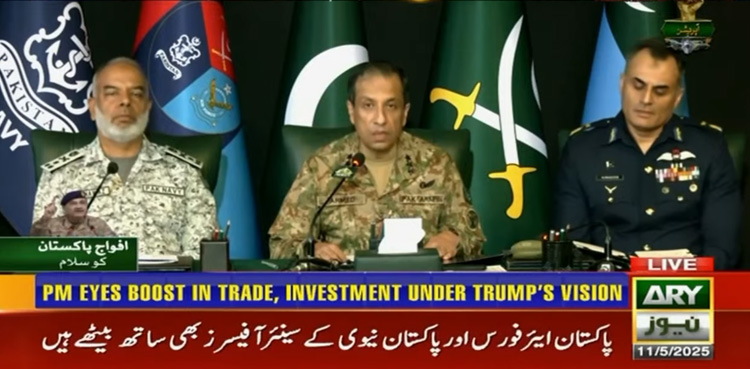Our Terms & Conditions | Our Privacy Policy
DG ISPR presser on operation Bunyan-un-Marsoos
Director General Inter-Services Public Relations (DG ISPR) Lieutenant General Ahmad Sharif Chaudhry has firmly clarified that Pakistan never requested a ceasefire during the recent military tensions with India. He made this statement while sharing detailed insights into the successful execution of Operation Bunyan-un-Marsoos.
DG ISPR in a joint press briefing alongside Air Vice Marshal Aurangzeb of the Pakistan Air Force (PAF) and Vice Admiral Rab Nawaz of the Pakistan Navy (PN) stated that “the desire for de-escalation came from the Indian side, not from us.”
“Pakistan made no such request for a ceasefire. The initiative came solely from India.”
Dispelling rumours circulating in certain circles, DG ISPR also stated unequivocally, “There is no Indian pilot in our custody.” He noted that during Indian attacks, some infrastructure was damaged and one aircraft suffered minor impairment.
“The aircraft will be operational again soon,” he assured, lauding the professional response of Pakistan’s forces.
Highlighting the coordinated efforts of the Pakistan Army, Navy, and Air Force, DG ISPR said, “All three services responded efficiently and decisively under Operation Bunyan-un-Marsoos.”
He particularly praised the country’s air defence systems, which were fully activated and performed with distinction.
“Our forces are always alert. Whether it’s a move or a misadventure, we are ready,” he warned.
On the Kashmir issue, he stressed that lasting peace is not possible without a just resolution in accordance with the aspirations of the Kashmiri people. He condemned the demolition of homes following recent events in Pahalgam.
He reaffirmed Pakistan’s consistent stance on the Indus Waters Treaty, stating, “The Government of Pakistan’s position is very clear.”
Summarising Pakistan’s reaction to India’s aggression, he concluded, “The world saw clearly who actually wanted to avoid escalation—our measured response said it all.”
In a significant revelation, DG ISPR detailed how Pakistan conducted targeted precision strikes on 26 Indian military installations using the Fatah-I and Fatah-II missile systems.
These included military sites in Suratgarh, Sirsa, Bhuj, Naliya, Adampur, Avantipura, Udhampur, Pathankot, Bathinda, Barnala, Halwara, Srinagar, Jammu, Mamun, and Ambala.
Notably, two Indian S-400 air defence systems in Adampur and Bhuj, along with BrahMos missile storage depots in Beas and Nagrota, were neutralised. Command centres and radar systems in Uri and Poonch were also destroyed.
The strikes specifically targeted locations linked to attacks on civilians in Azad Jammu and Kashmir, keeping civilian safety as a top priority.
Simultaneously, large-scale cyber operations disrupted India’s military infrastructure. Armed Pakistani drones also carried out surveillance over Indian cities, including New Delhi, showcasing Pakistan’s strategic reach and technological prowess.
He saluted the youth of Pakistan and acknowledged the media for standing firm against disinformation. Praising national unity, he thanked the Prime Minister, cabinet, and political leadership for their support, calling it a historic example of collective resolve.
Operations in Rajouri and Nowshera dismantled Indian intelligence networks involved in cross-border terrorism. Some hostile elements even surrendered, raising white flags after retaliatory action by Pakistani forces.
Indian drones also attempted intimidation through airspace violations, but Pakistan’s drone response proved its defensive strength.
“Our response met all three commitments: it was powerful, its timing and method were our own choice, and the world, not just Indian media witnessed it,” he said, concluding with prayers for the injured and tributes to martyrs.
Pakistan Navy Maintained High Alert after India’s False Flag Operation: Vice Admiral Rab Nawaz
Vice Admiral Rab Nawaz confirmed that the Pakistan Navy was fully prepared and on high alert following India’s false flag operation.
He revealed that Indian naval movements, especially around the ship Ratna Gri near Pakistan’s maritime boundary on May 6 and 7, were closely monitored.
Though the vessel was 400 nautical miles from Pakistan’s territorial waters, the Navy kept it under constant watch.
Strategic readiness ensured safe passage for commercial ships, and the Navy’s vigilance prevented any escalation. He noted that India backed off when civilian targets were hit, underlining the Navy’s preparedness.
Pakistani naval forces also tracked Indian submarines and aircraft, securing coastal zones. Measures were taken to counter potential missile threats to Karachi, confirming the Navy’s state of readiness.
PAF Scored Clear Victory in Aerial Combat: Air Vice Marshal Aurangzeb
Air Vice Marshal Aurangzeb credited Pakistan’s success to divine help and strategic foresight. He shared that the Pakistan Air Force (PAF) successfully downed multiple Indian aircraft and thwarted Indian aerial aggression.
Pakistan’s air defence system performed with excellence, thanks to constant readiness.
He praised Air Chief Marshal Zaheer Ahmad Babar for his leadership, attributing the air operations’ success to his vision.
He stated that India attempted drone attacks on civilian areas, but Pakistan’s radar systems and GPS jamming technology neutralised those threats effectively.
He revealed that the aerial combat score stood at 6-0 in Pakistan’s favour, underscoring PAF’s superior capabilities.
He concluded that the careful interception of Indian drones prevented civilian harm and reaffirmed Pakistan’s air supremacy in the conflict.
[ad_1]
Images are for reference only.Images and contents gathered automatic from google or 3rd party sources.All rights on the images and contents are with their legal original owners.
[ad_2]



Comments are closed.